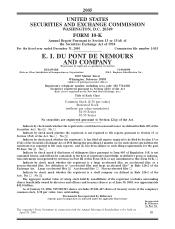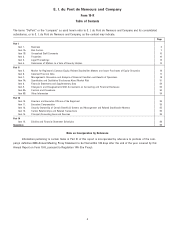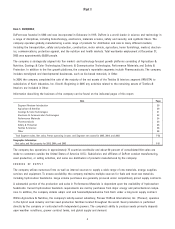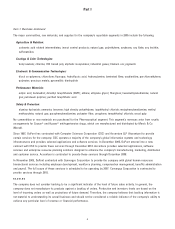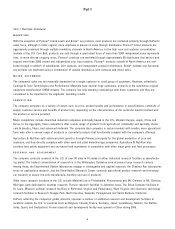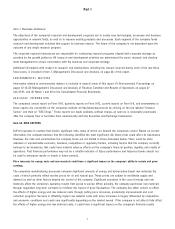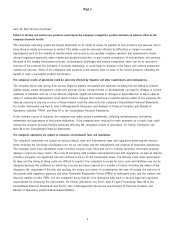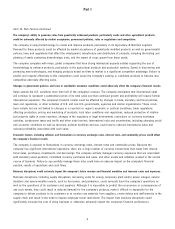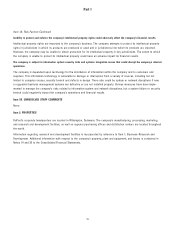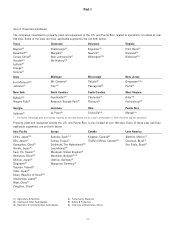DuPont 2005 Annual Report Download - page 8
Download and view the complete annual report
Please find page 8 of the 2005 DuPont annual report below. You can navigate through the pages in the report by either clicking on the pages listed below, or by using the keyword search tool below to find specific information within the annual report.Part I
Item 1A. Risk Factors–Continued
Failure to develop and market new products could impact the company’s competitive position and have an adverse affect on the
company’s financial results.
The company’s operating results are largely dependent on its ability to renew its pipeline of new products and services and to
bring those products and services to market. This ability could be adversely affected by difficulties or delays in product
development such as the inability to identify viable new products, successfully complete research and development, obtain
relevant regulatory approvals, obtain intellectual property protection, or gain market acceptance of new products and services.
Because of the lengthy development process, technological challenges and intense competition, there can be no assurance
that any of the products the company is currently developing, or could begin to develop in the future, will achieve substantial
commercial success. Sales of the company’s new products could replace sales of some of its current products, offsetting the
benefit of even a successful product introduction.
The company’s results of operations could be adversely affected by litigation and other commitments and contingencies.
The company faces risks arising from various litigation matters unasserted and asserted, including but not limited to product
liability claims, patent infringement claims and antitrust claims. Various factors or developments can lead to changes in current
estimates of liabilities such as a final adverse judgment, significant settlement or changes in applicable law. A future adverse
ruling or unfavorable development could result in future charges that could have a material adverse effect to the company. An
adverse outcome in any one or more of these matters could be material to the company’s Consolidated Financial Statements.
For further information see Part II, Item 7–Management’s Discussion and Analysis of Financial Condition and Results of
Operations subtitled ‘‘PFOA’’ and Note 24 to the Consolidated Financial Statements.
In the ordinary course of business, the company may make certain commitments, including representations, warranties,
indemnities and guarantees of third party obligations. If the company were required to make payments as a result, they could
exceed the amounts accrued, thereby adversely affecting the company’s results of operations. For further information see
Note 24 to the Consolidated Financial Statements.
The company’s operations are subject to extensive environmental laws and regulations.
The company’s operations are subject to various federal, state and international laws and regulations governing the environ-
ment, including the discharge of pollutants into the air and water and the management and disposal of hazardous substances.
The company could incur substantial costs, including cleanup costs, fines and civil or criminal sanctions, third-party property
damage or personal injury claims. The costs of complying with complex environmental laws and regulations, as well as internal
voluntary programs, are significant and will continue to be so for the foreseeable future. The ultimate costs under environmen-
tal laws and the timing of these costs are difficult to predict. The company’s accruals for such costs and liabilities may not be
adequate because the estimates on which the accruals are based depend on a number of factors including the nature of the
allegation, the complexity of the site, site geology, the nature and extent of contamination, the type of remedy, the outcome of
discussions with regulatory agencies and other Potentially Responsible Parties (PRPs) at multi-party sites, and the number and
financial viability of other PRPs. It is the company’s policy that all of its operations fully meet or exceed legal and regulatory
requirements for protecting the environment. For further information see Part I, Item 3–Legal Proceedings, Note 24 to the
Consolidated Financial Statements and Part II, Item 7–Management’s Discussion and Analysis of Financial Condition and
Results of Operations entitled Environmental Matters.
8

